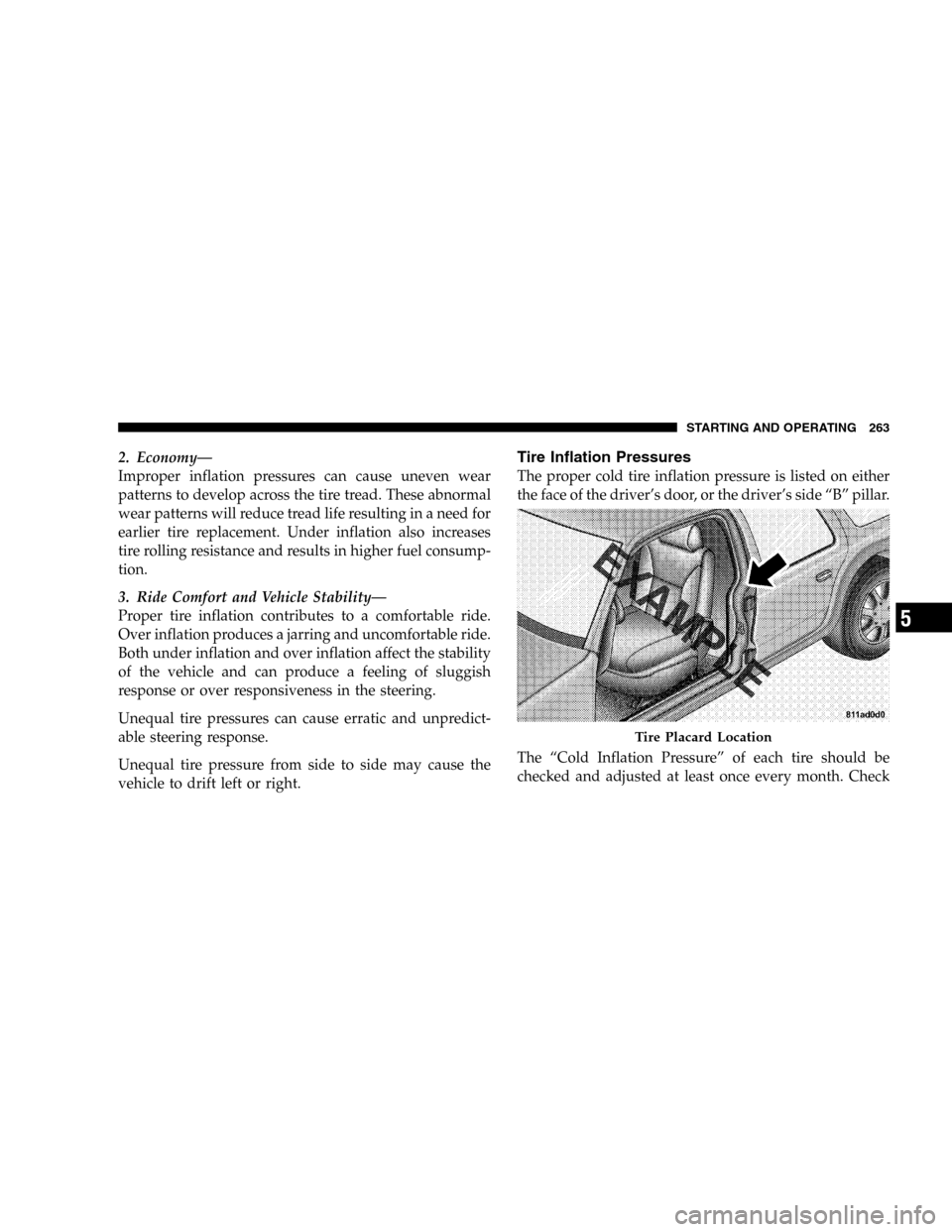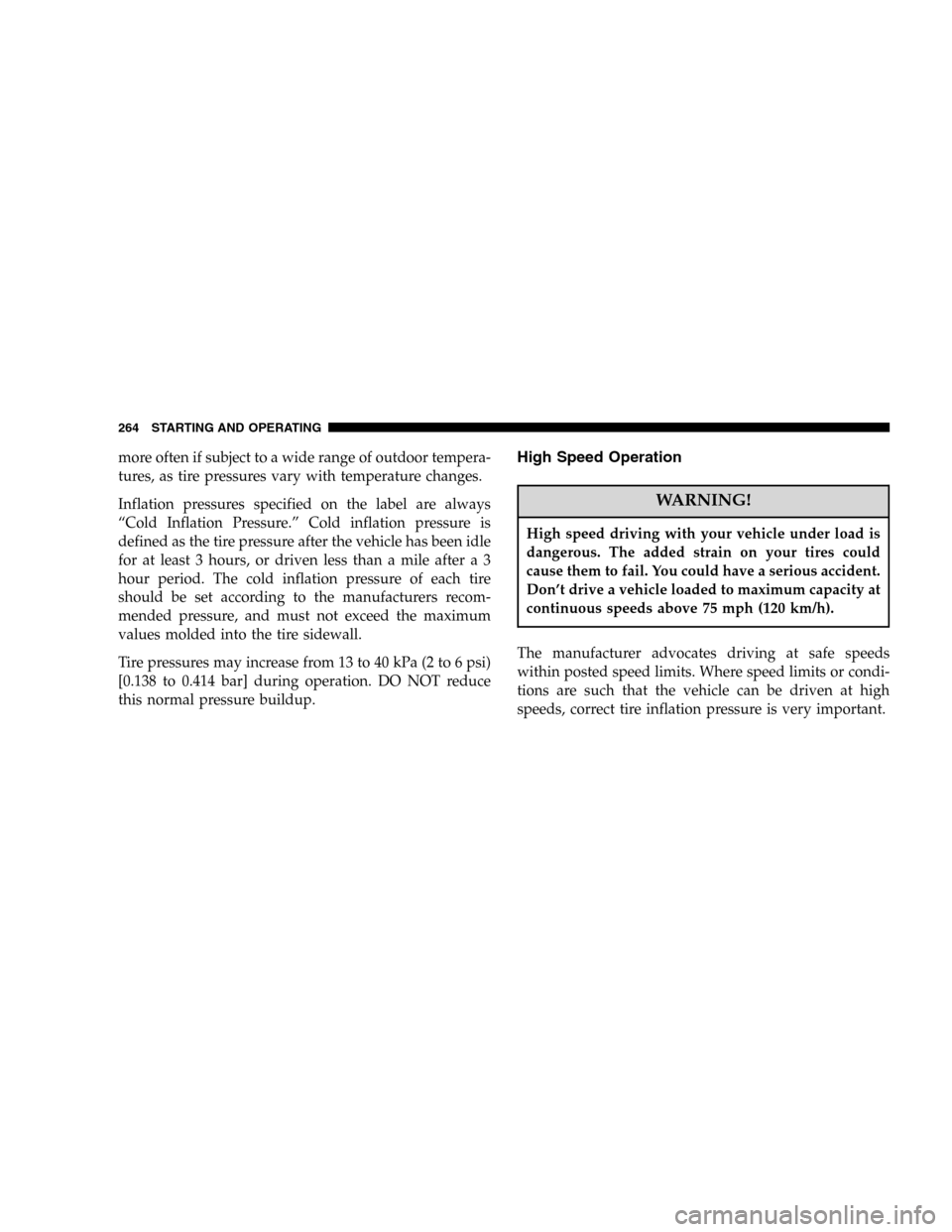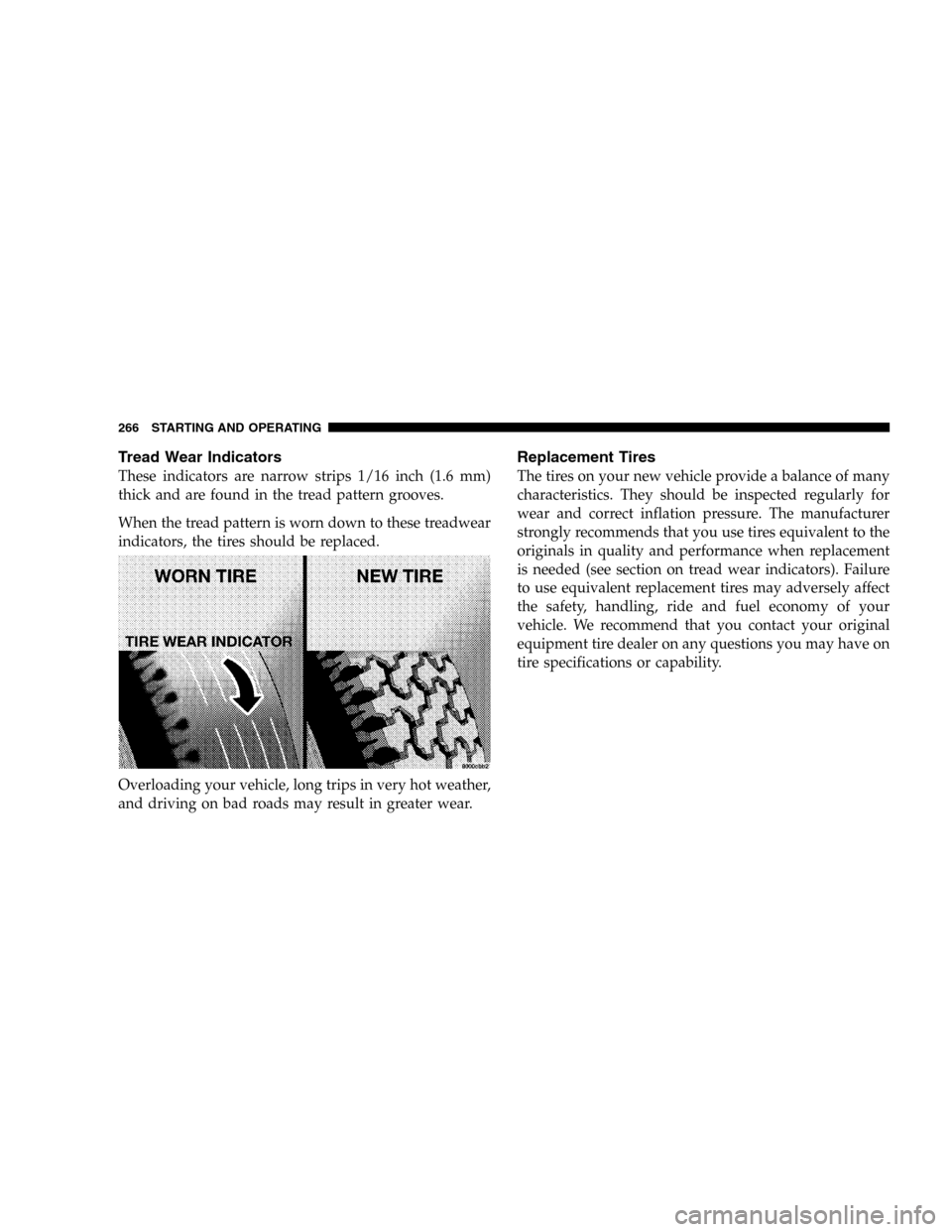2005 JEEP LIBERTY flat tire
[x] Cancel search: flat tirePage 262 of 424

WARNING!
Overloading of your tires is dangerous. Overloading
can cause tire failure, affect vehicle handling, and
increase your stopping distance. Use tires of the
recommended load capacity for your vehicle. Never
overload them.
TIRES — GENERAL INFORMATION
Proper tire inflation pressure is essential to the safe and
satisfactory operation of your vehicle. Three primary
areas are affected by improper tire pressure:1. Safety—
WARNING!
Improperly inflated tires are dangerous and can
cause accidents.
•Under inflation increases tire flexing and can
result in tire failure.
•Over inflation reduces a tire’s ability to cushion
shock. Objects on the road and chuck holes can cause
damage that results in tire failure.
•Unequal tire pressures can cause steering prob-
lems. You could lose control of your vehicle.
•Overinflated or under inflated tires can affect
vehicle handling and can fail suddenly, resulting in
loss of vehicle control.
Always drive with each tire properly inflated.
262 STARTING AND OPERATING
Page 263 of 424

2. Economy—
Improper inflation pressures can cause uneven wear
patterns to develop across the tire tread. These abnormal
wear patterns will reduce tread life resulting in a need for
earlier tire replacement. Under inflation also increases
tire rolling resistance and results in higher fuel consump-
tion.
3. Ride Comfort and Vehicle Stability—
Proper tire inflation contributes to a comfortable ride.
Over inflation produces a jarring and uncomfortable ride.
Both under inflation and over inflation affect the stability
of the vehicle and can produce a feeling of sluggish
response or over responsiveness in the steering.
Unequal tire pressures can cause erratic and unpredict-
able steering response.
Unequal tire pressure from side to side may cause the
vehicle to drift left or right.Tire Inflation Pressures
The proper cold tire inflation pressure is listed on either
the face of the driver’s door, or the driver’s side “B” pillar.
The “Cold Inflation Pressure” of each tire should be
checked and adjusted at least once every month. Check
Tire Placard Location
STARTING AND OPERATING 263
5
Page 264 of 424

more often if subject to a wide range of outdoor tempera-
tures, as tire pressures vary with temperature changes.
Inflation pressures specified on the label are always
“Cold Inflation Pressure.” Cold inflation pressure is
defined as the tire pressure after the vehicle has been idle
for at least 3 hours, or driven less than a mile after a 3
hour period. The cold inflation pressure of each tire
should be set according to the manufacturers recom-
mended pressure, and must not exceed the maximum
values molded into the tire sidewall.
Tire pressures may increase from 13 to 40 kPa (2 to 6 psi)
[0.138 to 0.414 bar] during operation. DO NOT reduce
this normal pressure buildup.High Speed Operation
WARNING!
High speed driving with your vehicle under load is
dangerous. The added strain on your tires could
cause them to fail. You could have a serious accident.
Don’t drive a vehicle loaded to maximum capacity at
continuous speeds above 75 mph (120 km/h).
The manufacturer advocates driving at safe speeds
within posted speed limits. Where speed limits or condi-
tions are such that the vehicle can be driven at high
speeds, correct tire inflation pressure is very important.
264 STARTING AND OPERATING
Page 266 of 424

Tread Wear Indicators
These indicators are narrow strips 1/16 inch (1.6 mm)
thick and are found in the tread pattern grooves.
When the tread pattern is worn down to these treadwear
indicators, the tires should be replaced.
Overloading your vehicle, long trips in very hot weather,
and driving on bad roads may result in greater wear.
Replacement Tires
The tires on your new vehicle provide a balance of many
characteristics. They should be inspected regularly for
wear and correct inflation pressure. The manufacturer
strongly recommends that you use tires equivalent to the
originals in quality and performance when replacement
is needed (see section on tread wear indicators). Failure
to use equivalent replacement tires may adversely affect
the safety, handling, ride and fuel economy of your
vehicle. We recommend that you contact your original
equipment tire dealer on any questions you may have on
tire specifications or capability.
266 STARTING AND OPERATING
Page 272 of 424

NOTE:The Indicator Lamp will only illuminate for the
four active road tires. A low spare tire pressure will not
cause the Indicator Lamp to illuminate
When the appropriate conditions exist, the Electronic
Vehicle Information Center (EVIC) displays the following
messages.
LEFT FRONT, LEFT REAR, RIGHT FRONT,
RIGHT REAR LOW PRESSURE, SPARE LOW
PRESSURE
One or more of these messages will be displayed in the
EVIC if a low tire pressure condition exists in one or more
tires.
Inspect all tires for proper inflation pressure, once the
proper tire pressure has been set, the TPM system
warning will reset automatically when the vehicle has
been driven for at least 2 minutes at or above 15 mph (24
km/h).
CHECK TPM SYSTEM
See your authorized dealer when this message appears in
the EVIC. This message indicates that a system fault
condition has been detected.
CAUTION!
The TPM system has been optimized for the original
equipment tires and wheels. TPM system pressures
have been established for the tire size equipped on
your vehicle. Undesirable system operation or sen-
sor damage may result when using replacement
equipment that is not of the same size, type, and/or
style. After-market wheels can cause sensor damage.
Do not use tire sealant from a can, or balance beads
if your vehicle is equipped with a TPM system, as
damage to the sensors may result.
272 STARTING AND OPERATING
Page 402 of 424

Caution, Exhaust Gas...................73,141
CD Changer........................187,193
CD Player..................184,189,191,195,198
CD Player Maintenance................... 211
Cellular Phone........................85,211
Center High Mounted Stop Light............ 355
Chains, Tire............................ 274
Changing A Flat Tire..................... 294
Charging System Light.................... 170
Chart, Tire Sizing........................ 255
Check Engine Light (Malfunction Indicator Light) . 310
Child Restraint......................63,68,70
Child Restraint Tether Anchors.............67,68
Child Safety Locks........................ 24
Climate Control......................... 212
Clock................................ 176
Clutch Interlocking Ignition System........220,229
Command-Trac Operation.................. 236
Compact Disc Maintenance................. 211Compact Disc Player..................178,184
Compass.............................. 137
Compass Calibration..................... 137
Compass Variance....................... 138
Computer, Trip/Travel.................... 135
Console, Overhead....................... 129
Contract, Service........................ 392
Converter, Catalytic...................... 317
Cool Down, Turbo....................... 224
Cooling System......................... 325
Adding Coolant (Antifreeze).............. 327
Coolant Capacity...................... 356
Coolant Level......................... 328
Disposal of Used Coolant................ 328
Drain, Flush, and Refill.................. 326
Inspection........................... 325
Points to Remember.................... 329
Pressure Cap......................... 327
Radiator Cap......................... 327
402 INDEX
Page 407 of 424

Identifying Your Engine................306,307
Ignition
Key ................................. 14
Wiring System........................ 319
Illuminated Entry........................ 19
Inflation Pressure Tires.................... 263
Information Center, Vehicle................. 131
Inside Rearview Mirror.................... 81
Instrument Cluster....................... 166
Instrument Panel and Controls.............. 165
Interior Appearance Care.................. 340
Interior Fuses.......................... 342
Interior Lighting........................ 117
Interior Lights.......................... 117
Intermittent Wipers...................... 125
Introduction............................. 4
Jack Location........................... 295
Jack Operation.......................294,296Jacking Instructions...................... 296
Jump Starting.......................... 299
Key, Programming........................ 18
Key Release Button....................... 15
Key, Replacement........................ 17
Key, Sentry............................. 16
Key-In Reminder......................... 16
Keyless Entry System...................... 25
Keys................................. 14
Lane Change and Turn Signals.............. 168
Lap/Shoulder Belts....................... 38
LATCH
(Lower Anchors and Tether for CHildren).....67,68
Lead Free Gasoline...................... 276
Light Bar...........................121,354
Lights............................. 117,350
Airbag............................62,174
INDEX 407
10
Page 415 of 424

Timing Belt............................ 319
Tire and Loading Information Placard......258,259
Tire Identification Number (TIN)............. 257
Tire Markings.......................... 254
Tire Safety Information.................... 254
Tires ................................. 262
Air Pressure.......................... 263
Alignment and Balance.................. 267
Chains.............................. 274
Changing............................ 294
General Information.................... 262
High Speed.......................... 264
Inflation Pressures..................... 263
Jacking............................. 294
Load Capacity.....................258,259
Pressure Monitor System................. 268
Radial.............................. 265
Replacement......................... 266
Rotation............................. 275Safety............................75,254
Sizes............................... 255
Spare Tire........................... 295
Spinning............................ 265
Tread Wear Indicators................... 266
Torque Converter Clutch.................. 235
Tow Hooks, Emergency................... 301
Towing............................283,302
Disabled Vehicle....................... 302
Recreational.......................... 287
Trailering............................ 283
Trac-Lok Rear Axle...................... 245
Trailer Towing.......................... 283
Minimum Requirements................. 286
Transfer Case........................236,336
Four-Wheel-Drive Operation.............. 236
Maintenance.......................... 336
Transmission
Automatic........................230,333
INDEX 415
10